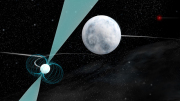 An international team of astronomers, including researchers from West Virginia University, using the National Science Foundation’s Green Bank Telescope have discovered a unique stellar system consisting of two white dwarf stars and a superdense pulsar.
An international team of astronomers, including researchers from West Virginia University, using the National Science Foundation’s Green Bank Telescope have discovered a unique stellar system consisting of two white dwarf stars and a superdense pulsar.
Detailed studies of this system may provide a key clue for resolving one of the principal outstanding problems of fundamental physics – the true nature of gravity.
Former WVU graduate student Jason Boyles, now a faculty member at Western Kentucky University, originally uncovered the pulsar in 2012 as part of a large-scale search for pulsars with the GBT.
Pulsars are neutron stars that emit lighthouse-like beams of radio waves that rapidly sweep through space as the object spins on its axis. The pulsar Boyles discovered lies approximately 4200 light-years from Earth, and spins at nearly 366 times per second. Such rapidly-spinning pulsars are called millisecond pulsars, and can be used by astronomers as precision tools for studying a variety of phenomena, including searches for the elusive gravity waves.
Subsequent observations showed that the pulsar is in a close orbit with a white dwarf star, and that pair is in orbit with another, more-distant white dwarf.
“Following the discovery observation, we routinely carry out follow-up measurements of the pulsar to characterize its properties,” Boyles said. “In this case, our measurements of the spin frequency revealed a complex orbit that could only be explained by invoking the presence of two orbiting white dwarf stars.”
Boyles, along with his research advisers, Duncan Lorimer and Maura McLaughlin, associate professors in the WVU Department of Physics and Astronomy, collaborated with an international team led by Scott Ransom, of the National Radio Astronomy Observatory; Anne Archibald, of the Netherlands Institute for Radio Astronomy; and Ingrid Stairs of the University of British Columbia to report their findings in today’s (Jan. 5) online edition of the journal Nature.
“This triple system gives us a natural cosmic laboratory far better than anything found before for learning exactly how such three-body systems work and potentially for detecting problems with General Relativity that physicists expect to see under extreme conditions,” Lorimer said.
The scientists began an intensive observational program using the GBT, the Arecibo radio telescope in Puerto Rico, and the Westerbork Synthesis Radio Telescope in the Netherlands. They also studied the system using data from the Sloan Digital Sky Survey, the GALEX satellite, the WIYN telescope on Kitt Peak, Arizona, and the Spitzer Space Telescope.
“The gravitational perturbations imposed on each member of this system by the others are incredibly pure and strong,” McLaughlin said. “The millisecond pulsar serves as an extremely powerful tool for measuring those perturbations incredibly well.”
The research on this system used techniques dating back to those used by Issac Newton to study the Earth-Moon-Sun system, combined with the “new” gravity of Albert Einstein, which was required to make the precise measurements. The system gives the scientists the best opportunity yet to discover a violation of a concept called the Equivalence Principle.
This principle states that the effect of gravity on a body does not depend on the nature or internal structure of that body.
“While Einstein’s Theory of General Relativity has so far been confirmed by every experiment, it is not compatible with quantum theory. Because of that, physicists expect that it will break down under extreme conditions,” Ransom said. “This triple system of compact stars gives us a great opportunity to look for a violation of a specific form of the equivalence principle called the Strong Equivalence Principle.”
Under the strong equivalence principle, the gravitational effect of the outer white dwarf would be identical for both the inner white dwarf and the neutron star. If the strong equivalence principle is invalid under the conditions in this system, the outer star’s gravitational effect on the inner white dwarf and the neutron star would be slightly different and the high-precision pulsar timing observations could easily show that.
“By doing very high-precision timing of the pulses coming from the pulsar, we can test for such a deviation from the strong equivalence principle at a sensitivity several orders of magnitude greater than ever before available,” Stairs said. “Finding a deviation from the Strong Equivalence Principle could help point us in the right direction toward a new, revised theory of gravity.”
For more information, contact Lorimer at 304.293.4867 or Duncan.Lorimer@mail.wvu.edu. McLaughlin can be reached at 304.293.4812 or Maura.McLaughlin@mail.wvu.edu. – See more at: http://wvutoday.wvu.edu/n/2014/01/05/wvu-astronomers-discover-unique-triple-star-system#sthash.agEWZvDR.dpuf